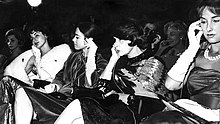Cinema of Argentina
| Cinema of Argentina | |
|---|---|

Iconic Argentine actresses in the 1961 Berlin International Film Festival: Isabel Sarli, Olga Zubarry, Tita Merello and Mirtha Legrand.
|
|
| Number of screens | 792 (2011) |
| • Per capita | 2.2 per 100,000 (2011) |
| Main distributors |
United International Pictures 23.7% The Walt Disney Company 22.4% Warner Bros. 16.2% |
| Produced feature films (2005-2009) | |
| Total | 52 (average) |
| Number of admissions (2012) | |
| Total | 46,386,856 |
| National films | 4,347,481 (9.4%) |
| Gross box office (2012) | |
| Total | ARS 1.31 billion |
| National films | ARS 111 million (8.5%) |
Cinema of Argentina refers to the film industry based in Argentina. The Argentine cinema comprises the art of film and creative movies made within the nation of Argentina or by Argentine filmmakers abroad.
The Argentine film industry has historically been one of the three most developed in Latin American cinema, along with those produced in Mexico and Brazil. Throughout the 20th century, film production in Argentina, supported by the State and by the work of a long list of directors and actors, became one of the major film industries in the Spanish-speaking world.
Argentina has won fourteen Goya Awards for Best Spanish Language Foreign Film, which makes it the most awarded country. It is also the only Latin American country that has won Academy Awards, in recognition of the films The Official Story (1985) and The Secret in Their Eyes (2009).
In 1896, French photographer Eugene Py was working for the Belgian Henri Lepage and the Austrian Max Glücksmann at the 'Casa Lepage', a photographic supplies business in Buenos Aires. The three all saw the debut of the Lumière Cinématographe in Argentina,"with a picture of the Lumiére's, took place on July 18, 1896." at the Teatro Odéon, only a year after its debut in Paris.
...
Wikipedia
